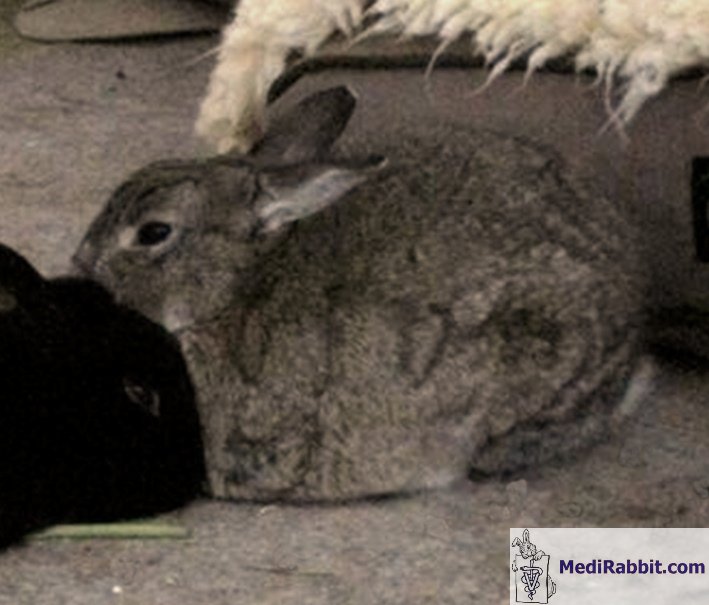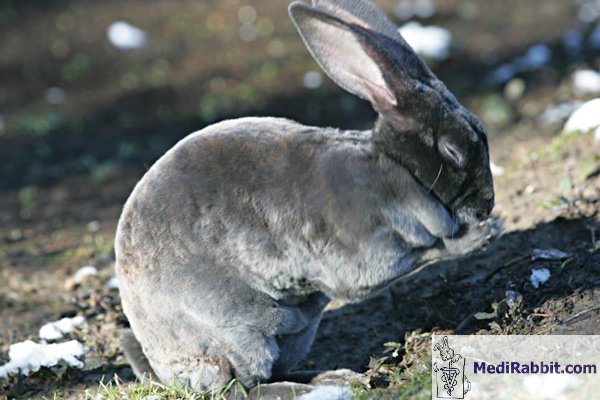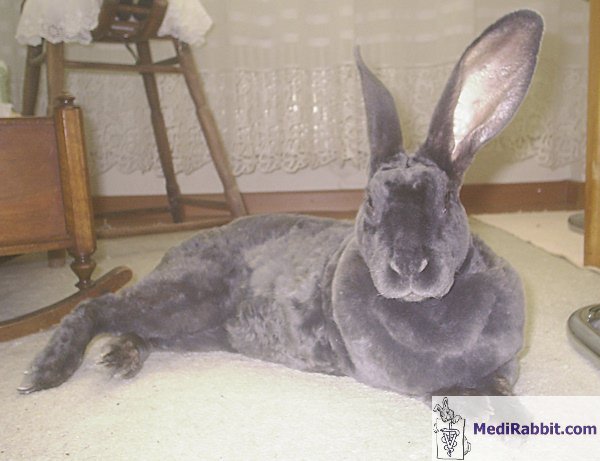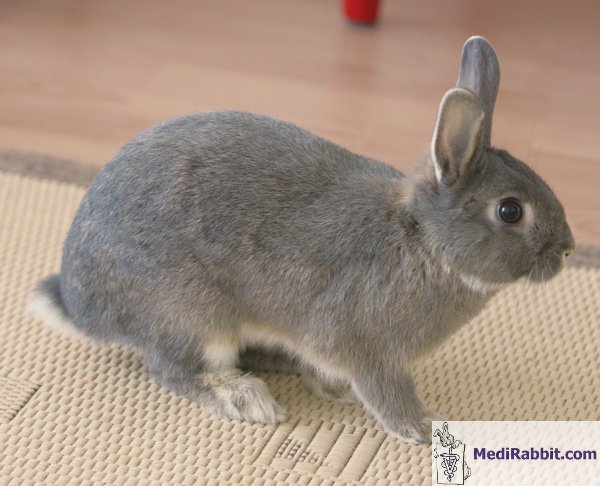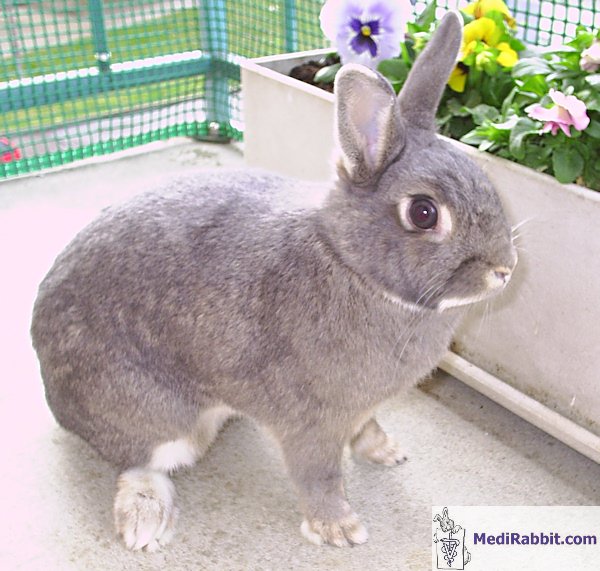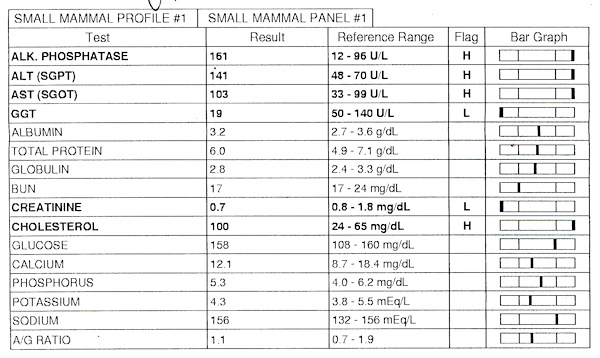Case report:
hepatic steatosis (fatty liver) in a rabbit
Esther van Praag,
Ph.D.
|
MediRabbit.com is
funded solely by the generosity of donors. Every
donation, no matter what the size, is appreciated and will aid in the
continuing research of medical care and health of rabbits. Thank you |
|
The liver is one of the biggest organs in the
rabbits. It plays an important role in the metabolism of energy by processing
nutrients, burning fats, in filtering blood from the digestive system, and in
the detoxification of molecules that may damage the body tissues.
Hepatic steatosis, or fatty liver disease, is the
abnormal accumulation of fats within liver cells. While the name of the
disease hints to fats, it is mainly caused by a diet too rich in
carbohydrates, - not fats, which leads to an excessive accumulation of fat in
the liver cells that replaces healthy tissue. Instead of metabolizing fats
and eliminating the excess, the fatty liver will start to store fat in its
tissues. The accumulation of fat in liver cells will interfere with liver
functions and metabolism. Impaired functioning of the liver may lead to an
accumulation of cellular waste products and toxins in the blood.
Fatty liver disease has been observed in obese
rabbits. Causes for this disease are not well understood. Obesity, a diet too
rich in fructose (a sugar found mainly in fruit) and carbohydrates (oat), an
underactive thyroid gland (hypothyroidism), and lack of exercise are commonly
observed. Further causes for fatty liver in rabbits include: ·
Anorexia, refusal to take in food
caused by dental disease or digestive disorders; ·
Lack of fiber in the diet; ·
Sickness in obese rabbits; ·
Gestation; ·
Toxins released by certain
bacteria, e.g., Escherichia coli. Its toxins can lead to a transient
increase of free fatty acids in the blood. Clinical signs
There are no clinical signs associated to hepatic
steatosis in rabbits. Tiredness, discomfort, anorexia, depression and/or
jaundice may appear when fat accounts for about 10% of the liver weight. Waste of muscle tissue is observed and can lead to
reluctance to move and exercise. Diagnosis
Diagnosis of hepatic steatosis is based on visual
examination and a complete blood test. Radiography and ultrasound of the
chest and abdomen can help determine the shape and enlargement of the liver
as well as the extent of fat excess in the liver. The presence of gallstones composed of excess
cholesterol may be detected. Blood panel
A blood panel will usually show
elevated liver enzymes, indicating inflammation of the liver tissue. Fat
oxidation will lead to damage of liver cells, rupture of their membrane and
leakage of liver enzymes into the bloodstream. Typically: ·
Alkaline phosphatase (Alk
phosphatase) is elevated. ·
Alanine transaminase (ALT) is
elevated. ·
Aspartate transaminase (AST) is in
the so-called "grey zone", just above the reference range. The AST/ALT ratio is lower than
zero (in this case: 103/141 = 0.73). This is indicative of viral liver
disease or steatosis/fatty liver disease linked to obesity. In this case, there is no liver
failure yet. Indeed, gamma glutamyl transpeptidase (GGT) is decreased and
below average. This marker is more sensitive than ALT and AST to liver
damage, but less specific. In case of damage GGT increases rapidly. Hyperlipidemia and elevated
triglycerides can accompany fatty liver disease. The abnormally high level of
cholesterol, indicating cholesteremia, remains unexplained. In rabbits it is
usually associated with liver failure, obesity, and, rare in pet rabbits, a
diet rich in fats. Glucose is high, but within range, ruling out
insulin resistance and obesity-related diabetes.
An elevated blood level of monocytes is nowadays believed
to be a marker for fatty liver disease (e.g. obesity).
Treatment
Measures must be taken without
delay to reverse the liver damage and to eliminate the excess of fat in that
organ. The treatment of fatty liver disease is slow and long. It aims at
reversing the fat metabolism in the liver and duration depends on the extent
of fat accumulation (in rats fed a diet high in carbohydrates, it has been
shown that they developed a fatty liver in proportion of the amount of sugar
fed. This can, furthermore, be accompanied by insulin resistance.). The rabbit should not receive any
further carbohydrate rich food and treats. Instead, it should receive a
healthy fiber-rich diet, rich in hay (see: Rabbit feeding for
suggestions). Obese rabbits must lose weight.
This process is gradual process – a 5 to 10% loss of initial body weight over
the next 6 months. The administration of milk thistle (Sylibum
marianum) extracts may help in the healing and recovery of the
liver cells. Without correction of the diet,
the liver tissue will be progressively replaced by scar tissue, which prevent
the normal circulation of blood within this organ. Fibrosis and regenerative
nodules (lumps that occur as a result of a process in which damaged tissue is
regenerated) will develop and replace the healthy liver tissue, leading to
loss of liver function (cirrhosis) and liver failure complications. During the recovery process, the
loss of weight may not be linear and gradual. It may stop during a few weeks,
than decrease more. This is normal and does not mean that recovery has
stopped. The level of liver enzymes in the blood may, furthermore, fluctuate,
before decreasing to normal. Prognosis for hepatic steatosis is guarded,
especially in older rabbits. |
||||||||||||
e-mail: info@medirabbit.com



